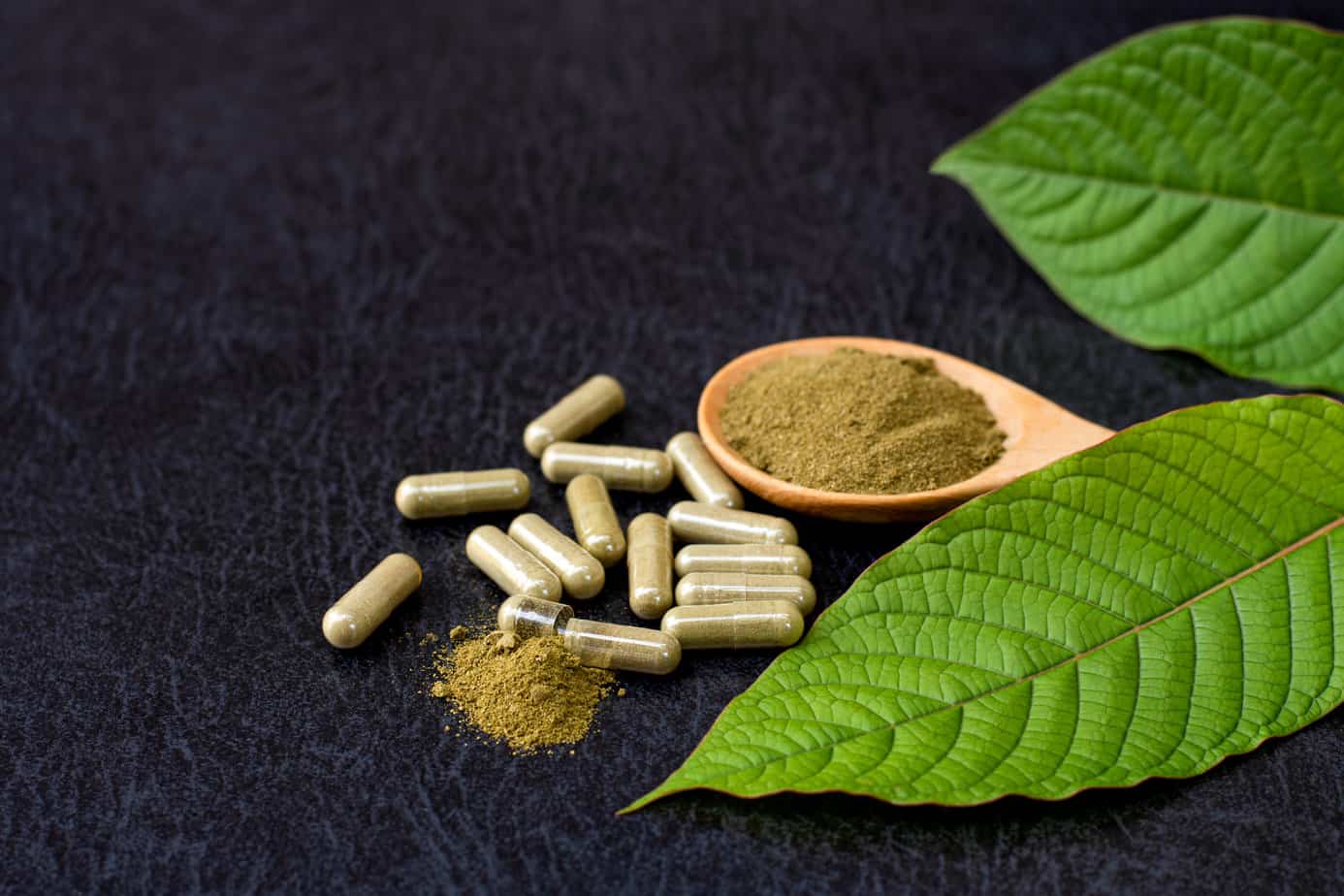Kratom (also known as Mitragyna speciosa) is a tree native to Southeast Asia and is a central nervous system stimulant that people use to boost physical and mental energy. As the drug appears more frequently in gas stations, health food stores, and online marketplaces across the US, we must understand the potential benefits of kratom use, but also its drawbacks and high risk of addiction.
What Is Kratom and Where Did It Come From?
The plant leaves contain psychoactive compounds (mitragynine and 7-hydroxy mitragynine) that act on opioid receptors in the brain to promote stimulant and pain-relieving effects. The type of effect users experience depends on how much of the drug is consumed. People taking lower doses may feel more alert, talkative, and energized. At higher doses, people might feel more of its sedative effects, which many people use to self-treat their opioid use disorder (OUD).
Kratom use dates back to the 1800s when laborers in Southeast Asia used it to sustain energy throughout the day and relieve pain associated with the demands of their job. They would chew the bitter leaves, mix them into tea, or grind them into a powder. The leaf is ingrained in the region’s culture, as some women use the substance as a household remedy for fevers, coughs, and anxiety. Men often consume it as a drink during social gatherings to unwind. Although the drug can be habit-forming, there is far less stigma attached to kratom than alcohol in countries like Malaysia and Thailand.
Over the last two decades, the US has seen a jump in kratom availability as well as usage. As of 2019, an estimated 10 to 16 million adults in America consume the drug regularly. Some experts believe the sudden popularity could be attributed to people’s interest in seeking natural alternatives for pain management and opioid withdrawal. The Drug Enforcement Agency (DEA) does not currently regulate the drug under the Controlled Substances Act, so regulation is up to the individual states.
Why Do People Use Kratom?
Many individuals turn to kratom leaves as a holistic alternative to manage chronic pain, seeking relief from conditions such as arthritis, fibromyalgia, or back pain. Some kratom supporters believe it can treat other physical and mental health ailments, including opiate and alcohol cravings; low sex drive; and symptoms of post-traumatic stress disorder (PTSD), anxiety, and depression. Research for kratom is still in its early stages and is by no means “safe” or approved for medical use.
While some people have reported positive experiences with the drug, its use and effects can vary among individuals. Each person’s reaction is different, so it’s important to consider potential risks and side effects before using. Some of the negative side effects of kratom use may include
- Irritability
- Nausea
- Vomiting
- Appetite loss
- Dry mouth
- Seizures
- Liver damage
- Psychosis
- Constipation
What Are the Different Forms and Strains of Kratom?
Mitragyna speciosa comes in leaf, powder, tincture, and capsule form, and can be brewed into tea. More recently, “K shots” have been seen on the shelves of some retailers. These products have highly concentrated amounts of kratom extract and are supposedly similar to energy drinks.
Also, leaves are available in various strains, each with unique physical and psychological effects. Different strains of kratom are produced based on how the trees are grown and when the leaves are harvested. The most common strains are red, white, and green. Some people claim that red strains have more calming and soothing properties, while white strains are used for energizing effects. Green strains are considered a middle ground between the other two.
Since the kratom industry lacks standardized regulations, this means that the quality, potency, and purity of products can vary significantly between different strains and vendors. There is not enough scientific, formal research to make an informed decision when it comes to kratom use.
Is Kratom Legal?
As of 2024, the use of Mitragyna speciosa remains controversial as it has not been regulated on a federal level. The US Food and Drug Administration (FDA) has warned consumers not to use the substance because it affects the same opioid brain receptors as morphine and carries the risk of addiction, abuse, and dependence.
The lack of regulation opens the doors for kratom products to have quality issues, such as being contaminated with other drugs. The Kratom Consumer Protection Act (KCPA) is a bill that was created to protect users in the industry, requiring vendors to follow specific safety guidelines and good manufacturing practices. The KCPA prohibits the sale of the drug to minors and bans dangerous substances that can alter the strength or quality of the kratom in a way that could harm the customer, as well as other safety measures.
As of February 2024, only a handful of states have passed the KCPA:
- Arizona
- Utah
- Georgia
- Nevada
- Colorado
- Oregon
- West Virginia
- Virginia
- Oklahoma
A few states have banned the drug entirely, while others have left it unregulated. As the FDA continues to research this drug, spreading awareness and exploring all possible side effects is important.
Can Kratom Be Used to Manage Opioid Addiction?
While some people have substituted kratom for opioids and seen success, there are also alarming reports of people struggling with the drug’s negative effects on their families, relationships, finances, and mental health.
Jana Wu, current Director of Cultural Integration at Mountainside, shares, “Several clients have reported that while kratom initially ‘helped’ them manage opioid cravings, their tolerance increased to a problematic level. This kratom abuse affected their daily living, with some spending thousands of dollars to support their regular use, missing work, and making choices they would otherwise not make had they not been under the influence of this substance.”
If you are experiencing opioid withdrawal symptoms, it is crucial to seek professional help. There are FDA-approved medications that can help manage withdrawal symptoms and reduce the risk of relapse.
Why Can Kratom Be Dangerous?
The drug may cause liver damage, respiratory depression, seizures, and even fatalities. Also, as mentioned before, it is not regulated or standardized, leading to inconsistencies in potency and purity. Not to mention, the side effects (good and bad) can be unpredictable, so it can be challenging for users to know how their body will react to the substance.
It is rare to overdose on Mitragyna speciosa on its own. According to CDC case reports, there were 91 fatalities resulting from kratom overdose in 2016–2017 throughout 27 states in the United States. In 84 of these 91 cases, other substances were also involved, with fentanyl being the most common.
One of the primary concerns is its addictive nature. Since the herbal substance acts similarly to opioids, prolonged and excessive use of kratom can result in physical dependence, withdrawal symptoms, and addiction. Individuals who develop dependence may experience drug cravings, insomnia, anxiety, restlessness, and irritability when attempting to quit or reduce their usage.
Kratom Addiction Treatment
For individuals with a lower level of dependence, undergoing detoxification may not be necessary. However, others may benefit from a medically supervised detox, which ensures a withdrawal process that is both safe and more manageable. Kratom withdrawal shares similarities with the withdrawal process associated with opiates, so providers may prescribe buprenorphine to manage uncomfortable symptoms and decrease cravings.
To maintain long-term recovery, it is suggested that you transition to a residential treatment program. Clinical counseling can help you identify and change self-destructive attitudes and behaviors, particularly those that lead to drug use. A therapist or recovery coach can work with you to help you cope with cravings, avoid substances, and prevent relapse.
Those who relied on kratom to relieve pain, stress, or mental health disorders, particularly as a “natural alternative” to traditional medicines, might benefit from wellness therapies. Mountainside offers qigong, acupuncture, and adventure-based therapies that can boost mental health and sustain long-term recovery. Clinicians will work with clients to find the most effective treatment plan that combines therapy and wellness practices.
Let’s Talk Kratom
Join us on Tuesdays at 7 PM (ET) for a virtual support group and discussion about this trending herbal substance. It is a central nervous system stimulant that can be used to boost physical and mental energy or treat pain. With growing interest in kratom, we must understand the potential benefits, possible drawbacks, and potential risks of addiction for some individuals. Register & Join the Meeting!
If you or a loved one is struggling with addiction, Mountainside can help.
Click here or call (888) 833-4676 to speak with one of our addiction treatment experts.

 By
By 







